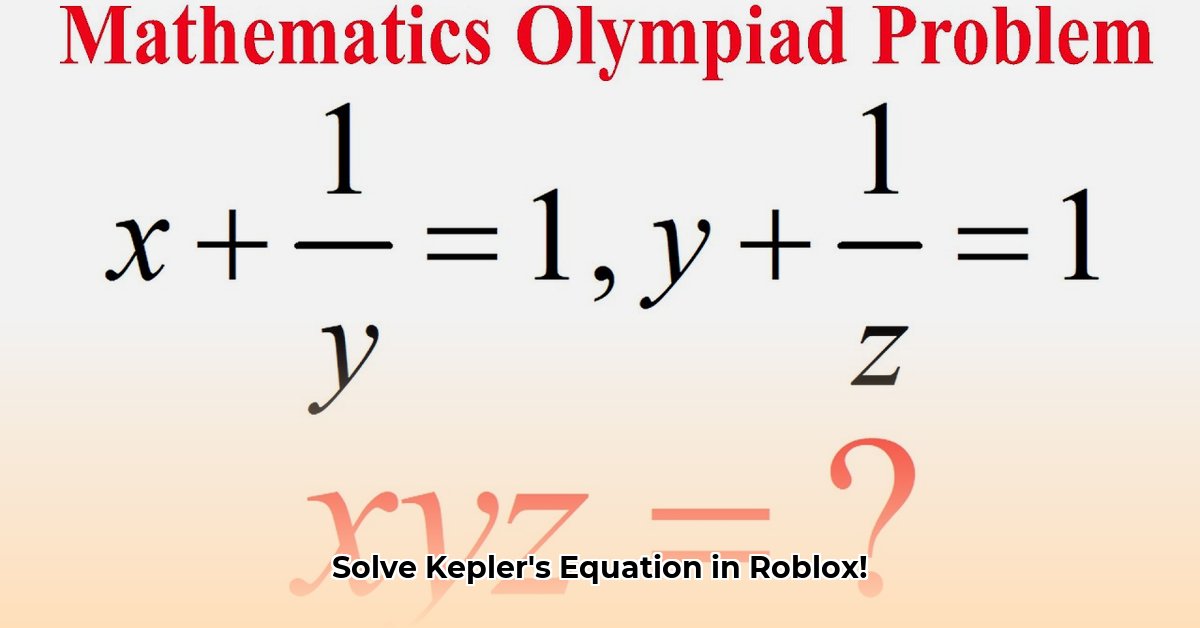
Cracking Kepler's Equation in Roblox: A Step-by-Step Guide Using the Newton-Raphson Method
Want to create realistic and engaging space simulations in Roblox? Accurate orbital mechanics are key, and that means mastering Kepler's Equation. This equation, fundamental to orbital dynamics, unfortunately lacks a direct analytical solution. This guide provides a practical, step-by-step approach to solving Kepler's Equation using the powerful Newton-Raphson method, a numerical technique ideal for finding approximate solutions to complex equations. We'll cover the theoretical underpinnings, provide executable Lua code for Roblox, and offer practical advice for achieving optimal results.
Understanding Kepler's Equation and the Newton-Raphson Method
Kepler's Equation elegantly relates three key orbital parameters:
- Mean Anomaly (M): Represents the object's theoretical position assuming uniform circular motion. It's essentially a measure of time elapsed since the object began its orbit.
- Eccentric Anomaly (E): The object's actual angular position in its elliptical orbit. This is what we want to solve for.
- Eccentricity (e): A measure of how elliptical the orbit is; a value of 0 represents a perfect circle, while a value close to 1 indicates a highly elongated ellipse.
The equation itself is: M = E - e * sin(E). The challenge lies in solving for E, which cannot be done algebraically. This is where the Newton-Raphson method becomes indispensable.
The Newton-Raphson method is an iterative numerical technique that refines an initial guess toward the true solution. Each iteration uses the function's value and its derivative to improve the approximation: E_(n+1) = E_n - f(E_n) / f'(E_n). Here, f(E) represents Kepler's Equation (E - e * sin(E) - M), and f'(E) is its derivative (1 - e * cos(E)). This iterative process continues until the desired level of accuracy is reached.
Implementing the Newton-Raphson Method in Roblox Lua
Let's translate the Newton-Raphson method into practical Roblox Lua code. This code provides a robust and efficient solution to Kepler's Equation, handling potential issues like division by zero.
Step 1: Define the Kepler Equation and its Derivative
local function keplerEquation(E, e, M)
return E - e * math.sin(E) - M
end
local function keplerDerivative(E, e)
return 1 - e * math.cos(E)
end
Step 2: Implement the Newton-Raphson Iteration
This function iteratively refines the guess for E until it converges to the solution or the maximum number of iterations is reached.
local function newtonRaphson(e, M, initialGuess, tolerance, maxIterations)
local E = initialGuess
for i = 1, maxIterations do
local fE = keplerEquation(E, e, M)
local fPrimeE = keplerDerivative(E, e)
if fPrimeE == 0 then return E end --Handle division by zero
local newE = E - fE / fPrimeE
if math.abs(newE - E) < tolerance then return newE end
E = newE
end
return E -- Return best approximation even if it didn't fully converge
end
Step 3: Setting Parameters and Solving
local e = 0.5 -- Eccentricity
local M = 1.0 -- Mean anomaly (radians)
local initialGuess = M -- Initial guess
local tolerance = 1e-6 -- Desired accuracy
local maxIterations = 10 -- Maximum iterations
local eccentricAnomaly = newtonRaphson(e, M, initialGuess, tolerance, maxIterations)
print(“Eccentric Anomaly: " .. eccentricAnomaly)
Remember to adjust parameters like tolerance and maxIterations based on your specific needs and desired accuracy.
Visualizing Results and Optimizing for Accuracy
Visualizing the iterative process within Roblox can greatly enhance understanding and debugging. Consider plotting the successive approximations of E. This allows for immediate identification of convergence issues or slow convergence cases.
Optimizing the initial guess significantly impacts convergence speed. While using the mean anomaly (M) is often a good starting point, exploring alternative methods, like those based on series expansions, can further enhance performance, especially for highly eccentric orbits. The choice of the initial guess should be tailored to the specific characteristics of the problem.
Comparison with Alternative Methods and Conclusion
While the Newton-Raphson method is highly effective, other numerical techniques, like the Halley's method or more sophisticated iterative approaches, may offer advantages in specific situations. Careful consideration of the problem's characteristics and computational constraints is crucial in selecting the most suitable method.
Mastering Kepler's Equation using the Newton-Raphson method opens up a world of possibilities for creating more realistic and engaging space simulations in Roblox. By combining the provided code with visualization tools, and experimenting with optimization techniques, you can elevate your Roblox space games to a whole new level of realism and sophistication. Remember that continuous refinement and exploration of advanced numerical techniques will further improve the accuracy and efficiency of your simulations.